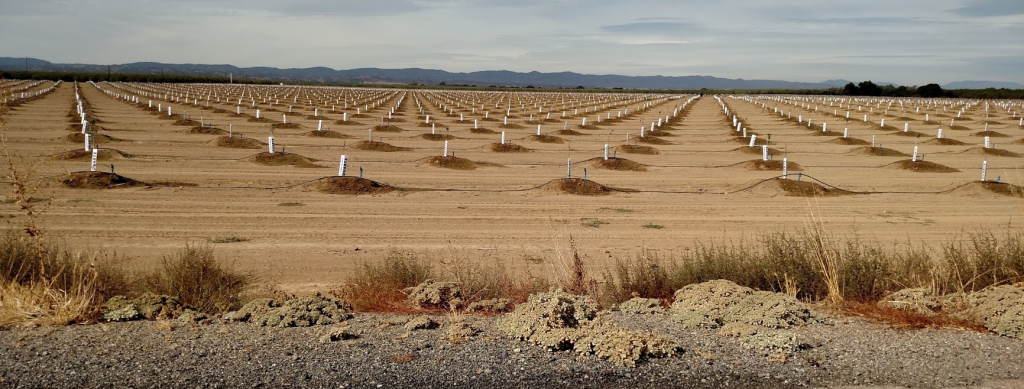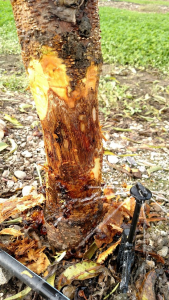Franz Niederholzer, UCCE Farm Advisor, Colusa and Sutter/Yuba Counties; and
Dani Lightle, UCCE Farm Advisor, Glenn, Butte, and Tehama Counties
Potted trees may be the nursery stock of the future, but they have challenges and a learning curve for growers accustomed to planting bare root trees. One of the major challenges is irrigating during the orchard’s first year. If your orchard is planted by tearing open the root ball of potted trees at planting, spreading the roots, and turning your trees into an almost a bare root condition, then disregard the rest of this post!
Leafed out trees are actively growing and begin using water immediately after planting. The challenge is irrigation water must go directly into the potted soil media. After roughly 30 days, when the tree roots have grown out of the potting media into the surrounding native soil, irrigation water delivery must shift from the original potted root ball to the native soil.

This newly planted potted almond orchard has microsprinklers set up to deliver water directly to the tree roots. Photo: D. Lightle.
Why this complete shift in irrigating potted trees after the first month in the ground? It’s because very little water will move across the large difference in textures between the potted soil media and the surrounding native soil – especially when the local soil is a fine textured soil (loam, clay loam, etc.) common to the Sacramento Valley prune growing regions. Water applied to the native soil after planting will be drawn to the continuous small pores of the dry native soil away from the newly planted tree, and not into the larger pores of the potting media. Water applied directly to the top of the potted soil media will move freely in the potted media, but won’t drain out of the potted media until the potting material is saturated, again because the water won’t move easily between the two soils. In both situations, water does not move readily across the boundary between the native soil and the potting media due to textural differences.
It takes about 30 days for tree roots to grow out of the pot and into the surrounding soil under good growing conditions. So, water the potting media for the first 30 days, then check to make sure roots have grown out into the surrounding native soil (yes, you will need to dig a hole!). If they have, move the water source, drip hose(s) or microsprinklers away from the tree. At first, put the water delivery within about a foot of the trunk, then, as the roots extend more, move the water source to its permanent location. Properly irrigating newly planted potted trees on flood irrigation (or furrow irrigation in the first year or two) is challenging unless you can individually irrigate (“tank”) trees several times during the first 30 days while the roots grow out of the potting media.
How can water be delivered directly to the potting soil and then shifted away? Here are some ideas (but not all options) offered by experienced nursery representatives:
- Stake a microsprinkler by the trunk and cap it to direct water downwards onto the potting soil. Once the roots have grown out beyond the potting media, take the cap off and move the sprinkler to a permanent location.
- Stagger a double-hose drip system so the emitters are evenly spaced along the tree row – basically making a big single line drip hose with emitters at half the distance apart along the row compared to each single hose. Throw a shovel of soil on top of the hose to keep water from running along the hose away from the tree, especially when trees are planted on cut-out berms (“islands”).
- Cut a shallow “V” in the top of the berm or island before the trees are planted and lay drip hose in the “V”, reducing the risk of water running down the hose away from the tree.
We’ve had numerous encounters that required troubleshooting irrigation problems with newly-planted potted trees, and we’ve consistently observed some common errors.
- Short irrigation sets are essential to meet tree water needs while also avoiding saturated conditions in the potting media immediately after planting.
- For the first month after planting, growers should not time irrigation by the use of soil moisture sensors set in the soil outside the potted media area. These measurements don’t show the water status of the roots in the potting media. Irrigate by water status of the root ball (dig down and feel it) and/or the estimations of ET use by small trees (http://cesutter.ucanr.edu/files/102712.pdf or ask your local farm advisor for a copy of “Irrigating young trees” by R. Scott Johnson, retired UCCE orchard specialist.
- When calculating water delivery volume, use only the water delivered by the emitters close to the roots, don’t include water applied out between the trees. Water delivered by a microsprinkler or drip emitterhalfway between two, newly planted potted trees is not being used by either tree.
- Don’t continue adding a large amount of water to the potting soil region for an extended period of time. This will saturate the potting soil and encourage crown rot – even in plum rooted trees (M29C, M40, M2624) that are generally tolerant of “wet feet”. This is extremely important for rootstocks that require well drained soils (hybrids like ‘Atlas’ and ‘Viking’, peach seedlings like ‘Lovell’).

Failure to move microsprinklers away from the trunk led to trunk disease and tree death. Photo: D. Lightle.
Adequate root zone moisture is essential to good, sustained tree growth and root health – especially in the first leaf. Excessive soil water will drown the roots or invite Phytophthora infection in the crown and/or roots. Dry soil limits tree growth and eventually, survival. The extra effort to get potted tree irrigation right the first year will pay off with the best possible start for the orchard.


Leave a Reply